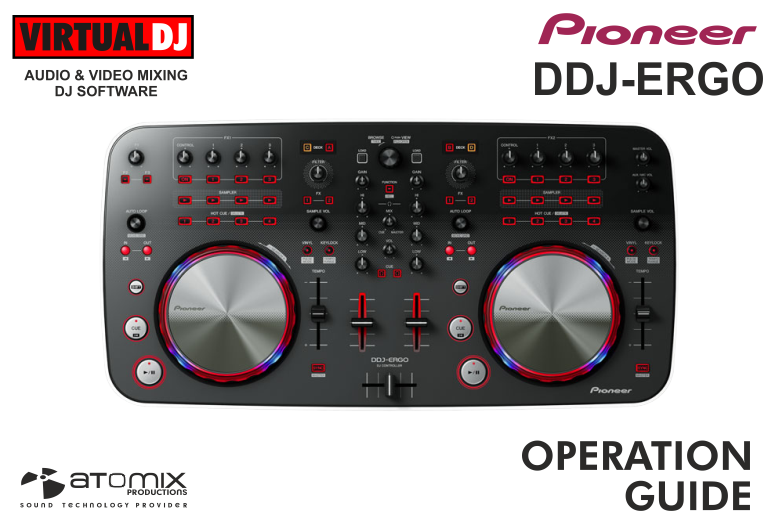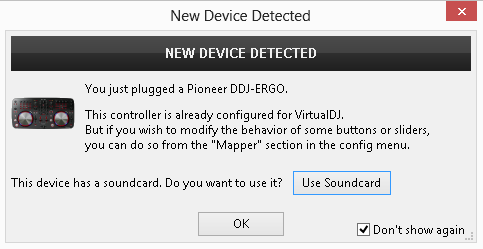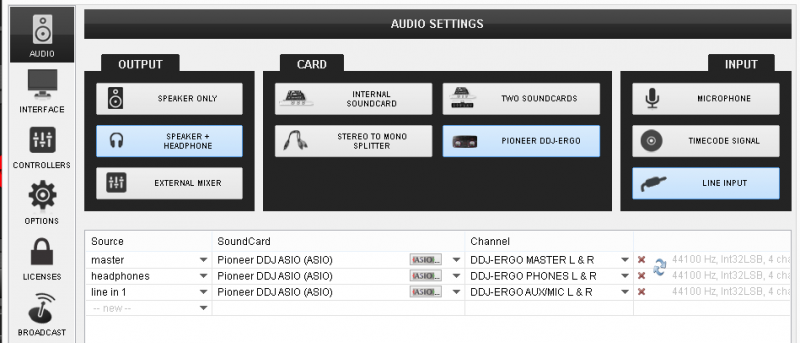PIONEER DDJ-ERGO

INSTALLATION
Firmware & Drivers
Firmware
Update the firmware of Pioneer DDJ-Ergo to the latest version from
http://www.pioneerdj.com/en/support/software/ddj-ergo/#firmware-update
Drivers
Install the latest ASIO drivers (for Windows only) from http://www.pioneerdj.com/en/support/software/ddj-ergo/#drivers
No Drivers are required for a Mac OSX computer. Mac OS standard audio drivers (Core Audio) will be automatically installed when the DDJ-Ergo is connected to a Mac computer with a USB cable.
VirtualDJ Setup
Once VirtualDJ 8 is launched, a Login Window will appear. Login with your virtualdj.com account.
A Pro Infinity, a Plus or a Pro Subscription License is required to use the Pioneer DDJ-Ergo. Without any of the above Licenses, the controller will operate for 10 minutes each time you restart VirtualDJ.
http://www.virtualdj.com/buy/index.html

Click on the "Use Soundcard" button and VirtualDJ will apply the pre-defined audio configuration (Speakers need to be connected to the Master Output of the DDJ-Ergo at the rear panel)
Click to OK.

The unit is now ready to operate.
MIDI Operation
A Pro Infinity or a PLUS license is required to customize the mapping of the unit.
Find more details at
http://www.virtualdj.com/wiki/VDJscript.html

AUDIO Setup

For further software settings please refer to the User Guides of VirtualDJ 8.
http://www.virtualdj.com/wiki/PDFManuals.html
LAYOUT

The functionality of each button, knob and connection per section (as shown in the image above) will be explained in detail in the next chapters
A. Deck Controls
B. Effects
C. Browser Controls
D. Mixer Controls
E. Master & Microphone
F. Front & Rear panels
DECKS

- PLAY/PAUSE. Play-Pause the track.
Hold SHIFT down and then press this button to "stutter-play" the track from the last set Cue Point. - CUE. When the Deck is paused, you can set a temporary Cue Point by moving the Platter to place the Audio Pointer at the desired location and then pressing the Cue Button. The Cue point can be stored using one of the 4 HotCue buttons (8)
During playback, you can press the Cue Button to return the track to this Cue Point. (If you did not set a Cue Point, then it will return to the beginning of the track.).
If the Deck is paused, you can press and hold the Cue Button to play the track from the Temporary Cue Point. Releasing the Cue Button will return the track to the temporary Cue Point and pause it. To continue playback without returning to the Temporary Cue Point, press and hold the Cue Button, then press and hold the Play Button, and then release both buttons.
Hold SHIFT and then press the CUE button to return the track at the beginning. - SHIFT. Press and hold this button to access secondary functions of other controls on the Ergo.
- LOOP IN. Set a Loop In (Entry) Point for a manual loop. If a loop is triggered, hold SHIFT down and then press this button to move the loop by 1 beat backwards.
- LOOP OUT. Set a Loop Out (Exit) Point for a manual loop. If a loop is triggered, hold SHIFT down and then press this button to move the loop by 1 beat forward.
- AUTOLOOP. Turn the encoder anti-clockwise or clockwise to half or double the size of the loop. Push the encoder to trigger an Auto Loop with the selected size.
Hold SHIFT down and then use the encoder to shift the CBG by one beat backwards or forward. - SAMPLER. Each one of the 4 Sampler buttons triggers a sample from the selected Sampler Bank of VirtualDJ. If a bank has less than 5 samples, both sides of the DDJ-Ergo will control the same samples. If a bank has more than 4 samples, the left side of the DDJ-Ergo will control samples 1 to 4 and the right side samples 5 to 8. The Leds of the Sampler buttons will be on, if a Sampler Slot is loaded and will blink when triggered.
Hold SHIFT down and press the same Sampler button to stop the Sample (useful if the Sampler is at the Unmute or Stutter mode) - HOTCUES. Each one of the 4 HotCue buttons assigns a Hot Cue Point (1 to 4) or returns the track to that Hot Cue Point.
When a Hot Cue Button is unlit, you can assign a Hot Cue Point by pressing it at the desired point in your track. Once it is assigned, the Hot Cue Button will light
Hold SHIFT down and then press a HotCue button to delete its assigned Hot Cue Point.
. - DECK SELECT. Switch between A or C decks for the left side and B or D decks for the right side of the DDJ-Ergo.
- FILTER. Apply a Resonance High Pass/Low Pass Filter to the left or right selected deck. When the knob is at the middle position (12 o’clock), no filter is applied. When the Pulse mode is enabled, the Blue Leds of the Jog ring will indicate how much filter is applied.
- SAMPLER VOL. Turn the encoder anti-clockwise or clockwise to reduce or increase the volume of the triggered Sample. Push the encoder to load the next Sampler Bank.
If a Sampler Loop is in Loop mode, hold SHIFT down and then use the encoder to half or double the size of the Sampler Loop. Hold SHIFT down and then push the encoder to select the next Sampler Trigger mode (On/Off, Hold, Stutter, Unmute). - VINYL. Press this button to toggle between the Vinyl (Scratch) and CD (Bend) mode. In Vinyl mode, use the outer ring of the platter to pitch bend.
Hold SHIFT down and then press this button to turn the Pulse mode on/off. When Pulse mode is enabled, the blue leds of the Jog ring will offer additional indications, such as the strength of the applied effect and filter, the current Master Deck and the beat difference between the left and right decks. - KEYLOCK. Press this button to turn Keylock (Master Tempo) on/off. If Keylock is enabled the pitch will change the tempo of the track but not it’s Key.
Hold SHIFT down and then press this button to select the next available Pitch range. - PITCH. Controls the track's playback tempo.
- SYNC. Press this button to automatically match the tempo of the track and align the CBG with the Master deck.
Hold SHIFT and then press this button to set this deck as Master Deck. All other decks will sync to the Master Deck when SYNC is pressed on that deck. Note that by default the Master Deck is set automatically by VirtualDJ to the deck that is currently playing out in Master. - JOGWHEEL. Pressure sensitive platter for Scratch and Bending. In Vinyl mode the platter is used for scratching and the outer ring for pitch bending. Hold SHIFT down and then use the Jogwheel to fast search (seek mode) through the track
EFFECTS

- F2. (available on left side only) Press this button to trigger the selected Video Transition. Hold SHIFT down and then use this button to select the next available Video Transition.
- F3. (available on left side only) Press this button to trigger the selected Master Video Effect. Hold SHIFT down and then use this button to select the next available Master Video Effect.
- F1 KNOB. (available on left side only) Use this knob to control the 1st parameter of the selected Master Video Effect (if the Effect has one).
- CONTROL KNOB. Use this knob to select an Effect from the Effects List of VirtualDJ for the left or right deck.
- FX PRM1. Use this knob to adjust the 1st parameter of the selected Effect. Hold SHIFT down and then use this knob to adjust the 4th parameter of the selected Effect (in case it offers one).
- FX PRM2. Use this knob to adjust the 2nd parameter of the selected Effect. Hold SHIFT down and then use this knob to adjust the 5th parameter of the selected Effect (in case it offers one).
- FX PRM3. Use this knob to adjust the 3rd parameter of the selected Effect. Hold SHIFT down and then use this knob to adjust the 6th parameter of the selected Effect (in case it offers one).
- FX ON. Press this button to turn on/off the selected Effect. Hold SHIFT down and then use this button to open/close the FX GUI at the right side of the Browser (offers all the effect parameters of the selected Effect)
- FX1 BUT. Use this button to control the 1st FX button of the selected Effect (in case the selected effect offers one). Hold SHIFT down and then use this button to control the 4th FX button of the selected Effect (in case the Effect offers one)
- FX2 BUT. Use this button to control the 2nd FX button of the selected Effect (in case the selected effect offers one). Hold SHIFT down and then use this button to control the 5th FX button of the selected Effect (in case the Effect offers one)
- FX3 BUT. Use this button to control the 3rd FX button of the selected Effect (in case the selected effect offers one). Hold SHIFT down and then use this button to control the 6th FX button of the selected Effect (in case the Effect offers one)
- FX1. Triggers the Beat Grid Effect on the selected left or right deck.
- FX2. Triggers the Flanger Effect on the selected left or right deck.
BROWSER

- BROWSE. Use the encoder to scroll through files or folders depending on the focused window of Browser.
Push the Encoder to set focus to the next visible Browser Window. Will cycle through Folder, Songs and Sideview Lists. If Sideview is not visible, it will only cycle though Folders and Songs List.
Hold SHIFT and then push the encoder to either open/close subfolders (if the focus is set to the Folders List) or cycle through the views of Sideview (if the focus is set to the Sideview). - LOAD. Press this button to load the selected track from Browser to the left (A or C) or right (B or D) deck (depending on the Deck select buttons 9). Hold the same button for more than 2 seconds to unload the left or right deck.
- PREVIEW/REC. Use this button to cycle through the available center panels of the default VirtualDJ skins (MIXER, VIDEO, SCRATCH and MASTER). Hold SHIFT down and then use this button to start/stop recording.
MIXER

- CROSSFADER. Blends audio and video between the left and right decks.
- VOLUME. Adjust the Volume of left/right decks.
- PFL. Use these buttons to send the output of left or/and right deck to the Headphones Output channel.
- PFL VOL. Adjust the Volume of the Headphones Channel. Hardware operation, not visible on the VirtualDJ GUI.
- PFL CUE/MIX. Adjust how the Channels and the Master Output blend at the Headphones Channel. When the knob is at minimum position, only the selected decks (depending on the PFL buttons) will be routed to the Headphones Channel. When the knob is at the maximum position, only the Master Output will be routed to the Headphones Channel. In all other positions, decks and Master will be blend.
- LOW (EQ). Adjust the Low (Bass) frequencies for left and right selected deck.
- MID (EQ). Adjust the Mid frequencies for left and right selected deck.
- HIGH (EQ). Adjust the High (Treble) frequencies for left and right selected deck.
- GAIN. Adjust the Gain of the left and right selected deck.
In/Out Controls

- MASTER VOL. Adjust the level of the Master Output. Hardware operation, movement not visible on the VirtualDJ GUI
- MIC/AUX VOL. Adjust the Volume of the Microphone Input. When the knob is at the far left position, the MIC is turned off. The knob will only operate if a Microphone Input is available in the audio Configuration (See Advanced Audio Setup). The knob does not control the Line In volume of VirtualDJ.
Front & Rear panels

- MASTER OUT (TRS). Connect this output to a PA system or powered monitors. The level of this output is controlled with the Master knob (42) on the top panel.
- MASTER OUT (RCA). Use standard RCA cables to connect this output to a speaker or amplifier system. The level of this output is controlled by the Master knob (42) on the top panel.
- MIC IN/VOL. Connect a 1/4" microphone to this input and use the knob to adjust its input signal (dB)
- INPUT SELECT. Put the switcher to the MIC position if you wish to use the Microphone Input as the Input Source of the built in audio Interface of the DDJ-Ergo. Put the switcher to the AUX position if you wish to use the Auxiliary Input as the Input Source of the built in audio Interface of the DDJ-Ergo (See Advanced Audio Setup)
- AUX IN/VOL. Connect an external audio source (CD player, media player etc.) to this input and use the knob to adjust its input signal (dB)
- ON/OFF. On/off switcher. The DDJ-Ergo is USB powered.
- USB. Connect a USB cable with your computer. This USB connection sends and receives audio and control information from a connected computer.

- HEADPHONES. Connect your 1/4" or 1/8" headphones to this output for cueing and mix monitoring. The Volume of the Headphones Output is controlled by the PFL VOL (36) knob at the top panel.
Advanced Audio Setup
The Pioneer DDJ-Ergo offers a single stereo Input which can be used as a Microphone or Auxiliary Line Input, depending on the INPUT SELECT switcher at the back of the unit. For the AUX, a special audio configuration is required.
Microphone
Connect a Microphone to the MIC socket (46) at the rear side of the unit. Set the INPUT SELECT switcher (47) at the back of the unit to MIC position, to route the Microphone Input through the Master Output of the audio interface and VirtualDJ. Use the small VOL knob (46) at the rear side to adjust its input signal level.
No special Audio configuration is required, as the microphone input is by default pre-selected for the DDJ-Ergo.
With the default audio configuration, the Microphone can be controlled by the MIC VOL knob (43) at the top of the unit and can be recorded as well.
LineInput
The Pioneer DDJ-Ergo cannot be used as a standalone mixer, so if you wish to route an external media source (CD player, media player etc.) to the Master Output, a Line Input should be added manually to the Audio configuration of VirtualDJ.
Connect your external media sources to the AUX Input (48) at the rear side of the unit. Set the INPUT SELECT switcher (47) at the back of the unit to AUX position, to route the Auxiliary Input to VirtualDJ. Use the small VOL knob (48) at the rear side to adjust its input signal level.
Click on the LINE INPUT button in the INPUT tab of the AUDIO SETTINGS and VirtualDJ will auto-create the necessary audio configuration. Since both Microphone and Auxiliary share the same Input channel, it is strongly advised to delete the Microphone line from the audio configuration (using the MICROPHONE button in the INPUT tab)

Once APPLY is clicked in the AUDIO tab, the AUX panels will be available in the decks of the VirtualDJ GUI. Click on the AUX buttons on either left or right deck, to route the Input to a software deck and control its volume using the Volume faders of the DDJ-Ergo.
